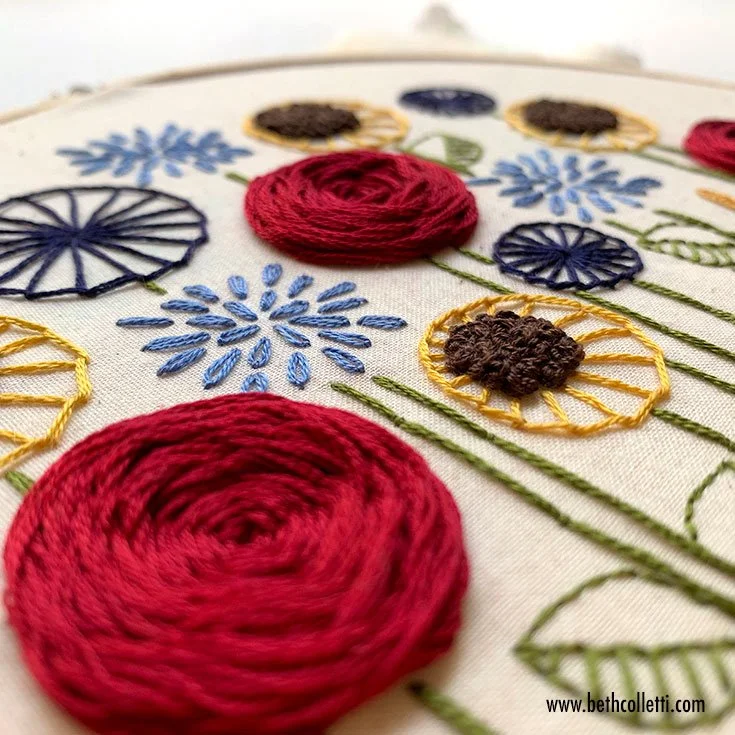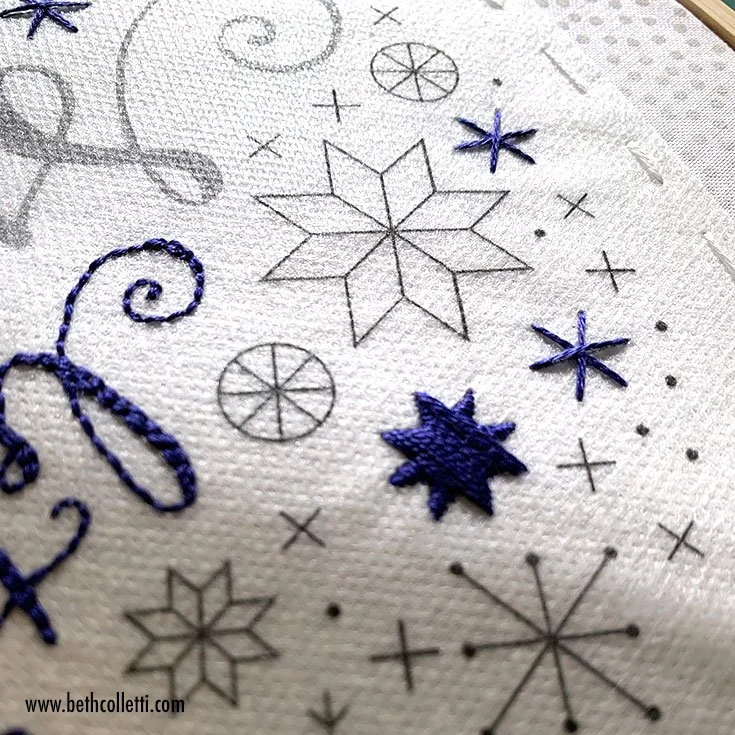(I am an Amazon Associate and from time to time will use affiliate links for products that I love, or that I think you will find useful. Should you choose to purchase with some of the provided links, I will receive a small commission from the companies I work with at no cost to you.)
Recently I sent out a survey to my newsletter readers asking them what their stitching goals were for this year, and how I could come alongside them, creating more helpful content to empower, encourage, and inspire them. There were several themes that kept popping up again and again in the survey results, and I think they are goals that many of us can relate to. So in today’s article I’m rounding up resources that speak to these intentions in the hope that they will help you achieve your stitching goals!
If your goal is to get better about making time for embroidery…
I think all of us wish we had more time for our creative projects. I know I do! Sometimes my schedule is just too full to squeeze in what I want to do, but more often than not, I don’t use my time as well as I’d like! Which side of this coin do you find yourself on right now?
Some tips if your schedule is really full:
Say yes with intention. // Examine your life and schedule to see if there are things you can say no to. Choose your yeses carefully so that you also have time for self-care and things that fill you up, like stitching!
Keep it simple. // Consider choosing smaller projects in this season that you can work on for fifteen minutes here or there as time or energy allows.
Acknowledge the season. // If you’re a mom of young kids, you’re dealing with health issues, you are getting ready to move, or any number of other things, this may just be a really busy season for you. That’s ok. Extend grace to yourself and know that things will not always be this way.
Some tips if you need to use your time better:
Where is your time going? // Map out how you spend your time over the course of a week. Look for pockets where you might be spending more time than you’d like on things such as social media scrolling or Pinterest browsing. Limit your focus on these time-wasters so that you can get back to the fun work of creating.
Relax and stitch. // Rather than choosing between two activities, think about how you might relax as you create. Can you watch TV and stitch? Or listen to an audiobook while you embroider?
Take a break from the internet. // Spending lots of time looking for inspiration on the internet can sometimes be a bit of a black hole. Go analog once in a while instead and visit the library, or your favorite bookstore. Pick out some books or magazines on your topic of interest that would be fun to flip through, and then actually start a new project. (Here are some of my favorite books for stitching inspiration.)
Start a daily stitch habit. // Many artists use a sketchbook daily to continually develop their art practice and explore new ideas. The same is true for an embroidery journal or daily stitch practice. Of course, stitching doesn’t have to be done daily. Decide on a timeframe that works for you and choose a large piece of fabric on which you can regularly practice your skills. Add stitches daily (or weekly, monthly, etc.) for fifteen minutes or more based on your mood, the season, textures you want to try, or freeform stitching - whatever’s inspiring you at the moment.
If your goal is to grow in confidence and/or improve your embroidery skills…
Like so many things, embroidery takes practice in order to grow skills. Don’t be too hard on yourself if you aren’t where you want to be. Just keep at it and you’ll look back and see the progress you’ve made! Most of all, remember to enjoy the process, or you’ll be tempted to give up. A couple of things that might help you on your stitching journey:
Address the basics. // Check out the article 8 Tips for Creating Neater Hand Embroidery Stitches
Narrow your focus. // Focus on one skill you want to grow, such as improving your satin stitch, or getting really comfortable with a spider wheel rose stitch, and choose projects accordingly. You’ll be less likely to get overwhelmed (and discouraged) when you work on one skill at a time.
Create an embroidery sampler. // Samplers are a great way to practice stitches, or try new ones. You can even create a sampler all of one stitch and repeat it in different weights and kinds of thread so you get really comfortable with creating the stitch. My online embroidery course includes six different samplers you can work on to practice the stitches and variations you are learning.
Be consistent. // One of the best ways to grow and improve your stitching skills is to keep at it. Whether you challenge yourself to embroider every day, week, or month, you’ll be able to see your progress over time, and that’s encouraging! Be sure to celebrate and give yourself a pat on the back.
Don’t compare your beginning with someone else’s middle. // I once read that quote in regards to starting a business, but it applies to all of life. You may be new or returning to embroidery while someone else has been practicing it for 20 years. Your skills are different and that’s ok. It doesn’t invalidate the creative work you are doing.
Options abound. // Remember that there isn’t only one right way to embroider. And you certainly don’t have to learn it all. Some people love thread painting while others think the geometry of sashiko is more beautiful. One person may want to focus entirely on felt appliqué while another prefers counted cross stitch. It’s all ok and one method isn’t better than another. Do what you enjoy most!
If you’re looking to improve on your stitching, check out the article 8 Tips for Creating Neater Hand Embroidery Stitches.
If your goal is to finish projects you’ve already started…
It’s so easy to pick up a new project that catches our fancy while forgetting about the other thirty we still have going on the side! I am as guilty of this as the next person and these are a few things I’ve found helpful:
Make space in your schedule. // Review the tips above about making time and see where you might be able to do that for yourself.
Sort and go. // Check out this article on tips for completing your UFOs.
Organize your project. // Pick up a stitching project journal to help you organize your makes as you stitch. These are great for any embroidery project, not just cross stitch. If you’re outside the US or would rather have loose pages in a binder, here’s a digital option you can download and print yourself.
Enjoy what you have. // Put a hold on your craft spending until you finish a certain number of works in progress.
Move on. // If there is a project you’ve started that you really have no interest in completing, part with it. No guilt. No shame. Donate it, pass it on to a friend who would enjoy working on it, or repurpose the supplies for a new project!
Need some help wrapping up your UFOs? Check out the article 3 Simple Tips to Help You Complete Your Stitching UFOs (UnFinished Objects).
If your goal is to learn and use new stitches…
It’s always fun to expand your stitching repertoire. Even if it’s not a stitch you use all of the time, using just the right stitch can add a lot of visual interest to a project whether you are embellishing felt appliqué, doing crazy quilting, trying freehand embroidery, decorating clothes, or simply stitching a variety of florals.
Consider an online embroidery course. // There are a ton of books out there that will show you illustrated stitches, though I’ve always found that it’s easy to miss some detail in an illustration. That’s why I prefer to watch stitching videos. I have several free embroidery videos available on my website, as well as an online course that will walk you through over 40 versatile stitches and demonstrate how you can combine their textures and shapes to add wow to your embroidery.
Stitch up samplers. // Samplers are not only a great way to learn and practice stitches, you can use them as beautiful art as well. They become a fantastic reference tool for you to keep on hand and they offer ideas for future projects. In my course, Step-by-Step Stitches for Creative, Textured Embroidery, I offer six different samplers that you can create as you learn the stitches, plus a series of bonus patterns and dozens of project prompts for stitching florals, leaves and other organic shapes.
Choose a more advanced pattern. // Whatever your skill level might be in embroidery, choosing a pattern that stretches you just a little will help you develop your skills and learn new stitches too.
Join a stitchalong. // Many stitchalongs not only provide the opportunity to complete a project in community, but offer the chance to learn some new stitches or techniques as well. Sign-up for my newsletter to be the first to know of stitchalong opportunities coming up!
Try an open-ended project. // Sometimes one of the best ways to get yourself to learn, and actually use, new stitches is to work through a project that causes you to flex your creative muscles a bit. Embroidery projects with prompts are great for this because you have some room to interpret the prompt in your own creative way. I offer a few free open-ended projects with prompts on my special resource page which is available to all newsletter readers.
One of six different samplers that I offer in my course, Step-by-Step Stitches for Creative, Textured Embroidery.
If your goal is to design your own patterns…
I’d love to connect! Simply contact me and tell me a bit more about this goal of yours and what’s holding you back the most.




